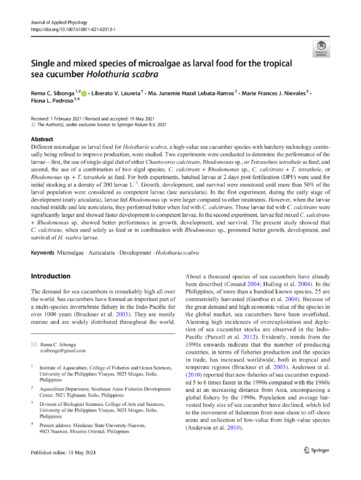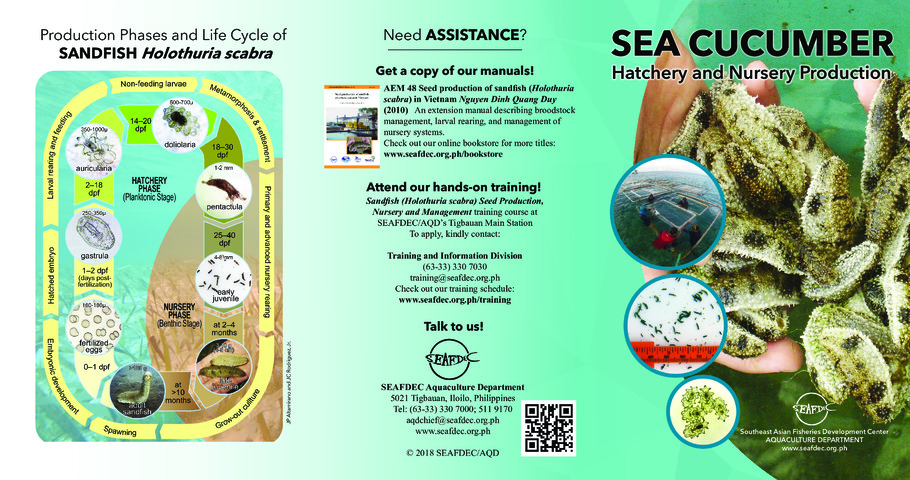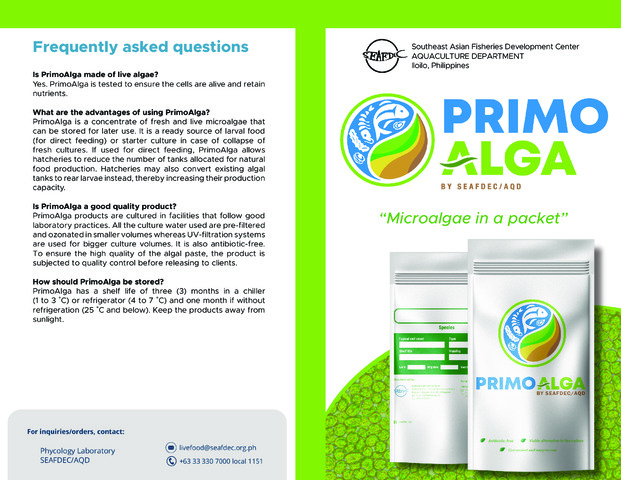| dc.contributor.author | Sibonga, Rema | |
| dc.contributor.author | Laureta, Liberato V. | |
| dc.contributor.author | Lebata-Ramos, Ma. Junemie Hazel | |
| dc.contributor.author | Nievales, Marie | |
| dc.contributor.author | Pedroso, Fiona | |
| dc.date.accessioned | 2022-05-25T08:33:28Z | |
| dc.date.available | 2022-05-25T08:33:28Z | |
| dc.date.issued | 2022-05-23 | |
| dc.identifier.citation | Sibonga, R. C., Laureta, L. V., Lebata-Ramos, Ma. J. H., Nievales, M. F. J., & Pedroso, F. L. (2022). Comparison of commercial Spirulina, live Navicula sp. and Chaetoceros calcitrans concentrate as settlement cues for sandfish, Holothuria scabra. Journal of Applied Phycology. https://doi.org/10.1007/s10811-022-02767-2 | en |
| dc.identifier.issn | 0921-8971 | |
| dc.identifier.uri | http://hdl.handle.net/10862/6324 | |
| dc.description.abstract | The settlement of sea cucumbers is a crucial phase of larval development because the highest mortality occurs at this stage. Substrates and cues are commonly used to induce larval settlement. Commercial algae and live benthic diatoms are the most common settlement cues being used. The present study evaluated Chaetoceros calcitrans concentrate as a potential settlement cue for H. scabra. Three settlement cues, replicated three times, were compared: commercial ‘Spirulina’, live benthic diatom Navicula sp., and C. calcitrans concentrate. Settlement substrates without cue served as control. ‘Spirulina’ paste and C. calcitrans concentrate were painted onto the settlement substrates, while settlement substrates were introduced into a Navicula sp. culture tank to enable attachment of the benthic diatom. Faster and higher settlement was observed in the treatment with ‘Spirulina’ paste as cue at 89% five days post introduction of substrates, compared with live Navicula sp. and C. calcitrans concentrate at 74% and 63% seven days post introduction, respectively. For the control, only 25% of the larvae have settled eight days after introduction to the substrates. ‘Spirulina’ paste and live Navicula sp. showed better settlement rates, but these were not significantly different compared with C. calcitrans concentrate. Therefore, C. calcitrans concentrate can be a potential settlement cue for H. scabra larvae. | en |
| dc.description.sponsorship | This study is part of the MSc thesis submitted to the College of Fisheries and Ocean Sciences, University of the Philippines Visayas and was conducted at the Aquaculture Department, Southeast Asian Fisheries Development Center (SEAFDEC/AQD) under the study code 5209-T-RD-BR0114. The authors greatly appreciate SEAFDEC/AQD for the use of facilities; the SEAFDEC/AQD Sea Cucumber Hatchery for the sea cucumber larvae; the SEAFDEC/AQD Natural Food Laboratory for the Navicula sp. and Chaetoceros calcitrans concentrate; Mr. Neil Tibubos, Mr. Jesus Rodriguez, Jr. and Mr. Romeo Tibudan for the assistance during the conduct of the experiment; and the anonymous reviewers for patiently reviewing the manuscript. | en |
| dc.language.iso | en | en |
| dc.publisher | Springer | en |
| dc.subject | sea cucumbers | en |
| dc.subject | Holothuria scabra | en |
| dc.title | Comparison of commercial Spirulina, live Navicula sp. and Chaetoceros calcitrans concentrate as settlement cues for sandfish, Holothuria scabra | en |
| dc.type | Article | en |
| dc.citation.volume | 34 | en |
| dc.citation.spage | 2099 | en |
| dc.citation.epage | 2105 | en |
| dc.citation.journalTitle | Journal of Applied Phycology | en |
| dc.subject.asfa | sea cucumber culture | en |
| dc.subject.asfa | biological settlement | en |
| dc.subject.asfa | metamorphosis | en |
| dc.identifier.essn | 1573-5176 | |
| dc.identifier.doi | 10.1007/s10811-022-02767-2 | |
| dc.subject.scientificName | Holothuria scabra | en |
| dc.subject.scientificName | Chaetoceros calcitrans | en |
| dc.subject.scientificName | Navicula | en |
| local.subject | Settlement cues | en |
| local.subject | Settlement percentage | en |
| local.subject | Chaetoceros calcitrans concentrate | en |



